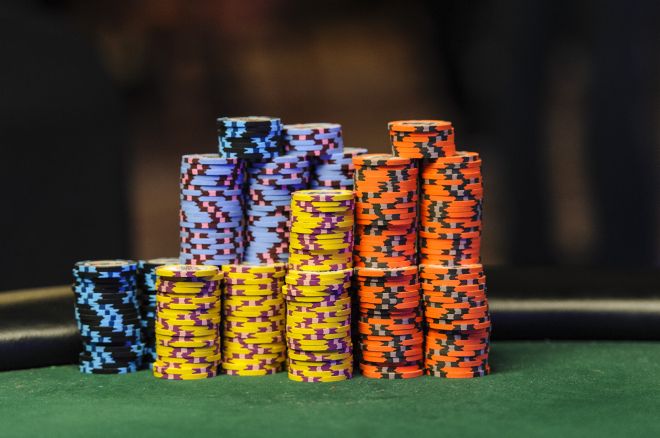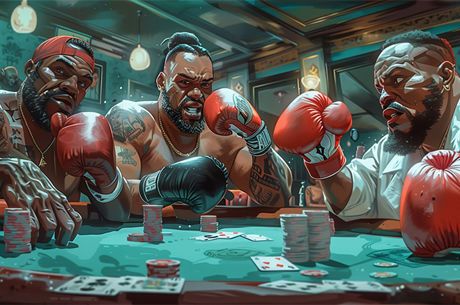Keep Your Tournament Game Simple: Five Common Stack Sizes and What To Do with Them

At any point of any poker tournament, you'll hear players refer to their stacks in terms of big blinds. "I started the hand with 27 big blinds" or "he had effectively 15 big blinds" are commonplace in any verbal hand history these days, and rightfully so. In tournament poker, stack sizes are extremely important.
While a player's stack size is extremely important, it's also something that changes frequently, especially when antes kick in and you're putting chips into the pot each hand before cards are even dealt. It's no secret that there are more specific plays one should make based on a stack size in preflop action, especially for the more beginner or intermediate player. Grouping stacks sizes into different areas can allow you to make better, more simplistic decisions preflop and lessen mistakes. With that, let's get into the five basic groups.
The Danger Zone
The old adage is that once you hit a stack of 10 big blinds, you're in serious trouble and need to double up quick. But even when you're at less than 15 big blinds, there aren't really any preflop plays you can make other than moving all in. When you've got less than 15 big blinds, there's really no maneuverability in your stack to allow you to raise-fold, so shoving to get your money in or to pick up the dead money (blinds and antes) is the play.
Additionally, you can shove a little wider with a stack of 12-14 big blinds when the antes kick in as opposed to when there are no antes. A little bit bigger of a stack will deter priced-in calls, and although you're risking more, you can win more because of the antes included in the pot. When there are only two blinds in the pot, it's often better to tighten up with regards to the hands you're shoving with, as you don't want to risk more to win less, plus you don't have antes eating at your stack every hand.
Three-Bet Shoving Time
When you're in the range of 15-25 big blinds, you're able to open things up a little more, but only just a little. Because this stack size if a little to big to simply open-shove to pick up the blinds and antes, this stack works great for three-bet shoving, especially over habitual loose-aggressive openers.
When you're on the higher end of this group, towards 25 big blinds, you can certainly raise-fold, but you're not going to survive more than one or two of those at most, so be selective with the hands you play. If you've fallen to the lower end and closer to 15 big blinds, it's time to start thing about adopting the shove-or-fold strategy discussed prior, but still look for good spots to three-bet shove.
The Most Common Stack
The next group is much more fun, as with 26-35 big blinds you've often got a very playable stack size. This is also one of the most common stack sizes seen in tournament poker, especially in the mid-late stages. The range of hands you play, both by opening with raises yourself or by calling the raises of other players, is vastly increased, but be aware that you likely have too big of a stack to three-bet shove without a premium had and risk getting called. When you three-bet shove with this size stack, you're more often than not only going to get called by quality hands, so you'll want to have one yourself.
When you get on the higher end of this group with closer to 35 big blinds, you can also look for inducing plays, such as three-betting with a powerful hand looking to induce your opponent to shove thinking he or she has fold equity on you.
Let Freedom Ring
The fourth group, the group of 36-50 big blinds, is almost total freedom, although you should exercise some caution so that you're not being taking of by players who view you as a loose-aggressive cannon and begin to find spots to three-bet shove on you. You're also deep enough here that you don't really want to be turning a lot of your hands into bluffs, so look to play flops instead of reraising with the intention of folding to another reraise.
It's a Party
Lastly, anything over 50 big blinds is a party. Invite your friends, splash around some chips, and enjoy applying pressure to those middling and average stacks. Poker tournaments are supposed to be won, not just given to you. Time and time again you see top-quality players with large stacks abusing their opponents en route to a victory. With this stack size, it's important to not settle. It's big mistake that many lesser-experienced players make to get ahold of a big stack and then tighten up because they don't want to risk losing it. In fact, you should be doing the opposite. Open up your starting-hand selection, play more pots, see more flops, and take more chances at being aggressive.
When you have over 50 big blinds, you can afford to takes chances and you'll find a lot of times those chances will work out in your favor either through a little luck or simple aggression. No one wants to tangle with the big stack and risk elimination, especially on the bubble of a tournament. Use this stack size to go out and win the thing.
Want to stay atop all the latest in the poker world? If so, make sure to get PokerNews updates on your social media outlets. Follow us on Twitter and find us on both Facebook and Google+!








